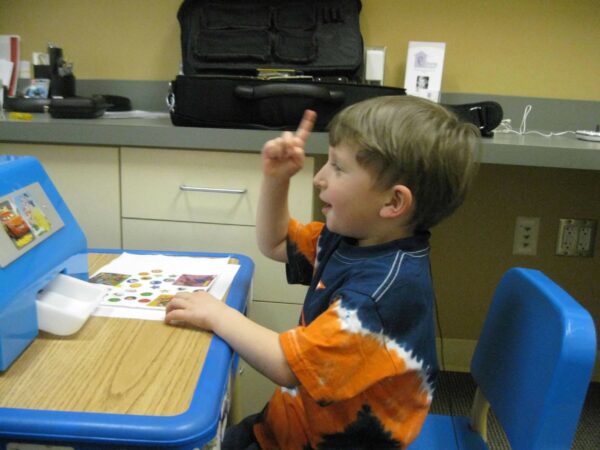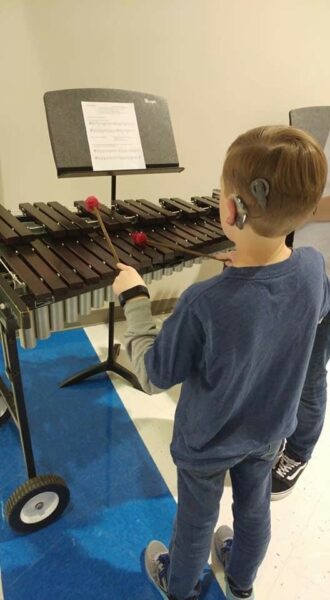As a child, Micah started to slowly become non-responsive with his family and friends. Eventually it was determined that he was experiencing hearing loss from Cytomegalovirus, or CMV. It was identified that cochlear implants could potentially help Micah, and his family decided to move forward with the technology. After years of speech therapy and rehabilitation, Micah is an outstanding student and percussionist as part of his school marching band. Learn Micah’s story here:
“When I was 3 years old, my parents noticed something seemed off with my language development. I had been learning words like most other children my age, but then I started losing that vocabulary. It got to the point where I had forgotten people’s names and when my parents would call me, I wouldn’t respond. My parents knew something significant was wrong, but since I had a normal newborn hearing screening, proving that I was slowly losing my hearing was difficult.
Two years later, at age 41, after many appointments and tests, my parents and several audiologists concluded that I was now almost completely deaf. It was determined that an illness I had as a newborn, Cytomegalovirus (CMV), caused delayed onset hearing loss.
 Two senses offered through technology
Two senses offered through technology
As a result of my diagnosis, I underwent surgery for cochlear implants; a hearing device that grants the user sound perception. It was a difficult decision for my parents. They considered American Sign Language (ASL), but ultimately wanted me to grow up hearing and speaking, since that was now an option through technology. Based on research, reading reviews and recommendations from friends, they chose Cochlear as the brand of implant I would receive.
My surgery was at the University of Virginia hospital, and everything went great. A few weeks later it was time to get my implant activated and finally be able to hear. We headed to UVA to work with an audiologist who would change my world.
The technology in front of me was both incredible and overwhelming. My new processor was connected to a computer, and each of the 22 electrodes were activated one at a time. Each time I heard a new sound, I had to press a button and a child-friendly machine dispensed a sticker.
 The importance of speech therapy and rehabilitation
The importance of speech therapy and rehabilitation
Cochlear implant activation is not an instant fix like putting on a pair of glasses to see better. It takes weeks to months to years of listening practice for the brain to process what it’s hearing into meaningful sounds. Thus began hundreds of hours of speech and language therapy. For the next year, I traveled to UVA weekly, went to Radford University biweekly and worked with a Montgomery County Schools speech teacher within my preschool three times a week.
In addition to all the speech therapy, I worked with a hearing teacher four times a week, even through the summer. My language skills sky-rocketed, so 11 months later, I got my second implant on my left ear, and it was life-changing.
I could hear even better than before and now I could tell which direction sounds were coming from. I had never noticed the GPS talking in our car, but as soon as the second processor was activated, I asked my parents, ‘WHO is that talking in the car?’ Soon I was identified as ‘twice exceptional’ in school. I was utilizing gifted services and special education services at the same time throughout elementary school.
All of this language work was taxing, but it was worth it. My language development scores went from the second percentile to the 77th percentile in just one year and continued to climb. By the time I started middle school, I had caught up to my peers. I earned several perfect scores on state reading and math end of year assessments. I kept the gifted services but no longer needed an IEP (Individualized Education Plan).
Real world scenarios with sound processors
Losing my hearing at a very young age means I have had to wear cochlear implants for a long time. While they have impacted my life so positively, there are times when I have to take them off. When swimming in a lake or the ocean, I take my processors off and I have to be very aware of my surroundings. Also, when I go swimming, it’s so that I can have fun and hang out with my friends, but it’s nearly impossible to engage in conversation when I can’t hear; instead, I read their lips. That makes me all the more thankful to be able to put my processors back on when I get out of the water!
A unique scenario that I have encountered using my cochlear implants is when traveling and going through the airport. I don’t go through the metal detectors for the safety of the implant in my head, instead, I go around the machine and get scanned down by the metal detector wands from my torso to the rest of my body. However, the fact that I can hear and talk like most people and not rely on sign language far outweighs any of these scenarios where I am without my sound processors.
Although there are some unfavorable effects of being a cochlear implant user, there are also advantages. The first of which is silence. When I go to bed, I don’t wear my processors, which means there is complete silence while I sleep. I love it! And I have my own special bed shaking alarm to wake me up.
 My favorite features and benefits
My favorite features and benefits
Another cool feature is that my cochlear implants are compatible with Bluetooth®2! I can listen to music or watch television on my phone3 and not wear headphones. The sound practically goes straight to my ears. My friends are amazed. Finally, one of my favorite activities as a high school student is playing percussion in the marching band. In the fall of 2023, our band was awarded first place grand champion of the day at a marching band festival. I can’t imagine not playing music with my friends every day, and I know it wouldn’t be possible without my cochlear implants.
There have been many effects of going deaf; some are positive and some are negative. The decision to receive cochlear implants became the most rewarding moment in my life. Yes, I had to go to speech and auditory therapy for many years and it was a tedious process, but it all contributed to me becoming a gifted student and talented musician.
Although I’m unable to speak with my friends when we go swimming because I remove my sound processors (Cochlear does offer an accessory called the Aqua+, that allows Cochlear™ Hearing Implant recipients to swim and participate in water activities), I get silence during the night, which most people don’t have. My implants have Bluetooth, so I can listen to music wherever I go. I have grown accustomed to hearing through technology, and if I could go back and change the fact that I’m deaf, I don’t think I would. I am thankful.”
If your child has been diagnosed with hearing loss as a result of Cytomegalovirus or CMV, cochlear implants may be a solution for them, just like Micah. Learn about this technology today!
- In the United States, the Cochlear Nucleus 24 cochlear implant system is intended for use in children 9 months to 24 months of age who have bilateral profound sensorineural hearing loss and demonstrate limited benefit from appropriate bilateral hearing aids. Children 2 years of age or older may demonstrate severe to profound hearing loss bilaterally. In Canada, the Cochlear Nucleus Implant System (CI500 and CI600 Series) is intended for use in children 9 months to 24 months of age who have bilateral profound sensorineural hearing loss and demonstrate limited benefit from appropriate bilateral hearing aids. Children two years of age or older may demonstrate severe to profound hearing loss bilaterally.
- The Bluetooth® word mark and logos are registered trademarks owned by Bluetooth SIG, Inc. and any use of such marks by Cochlear is under license.
- For a full list of smartphone and app compatible devices, visit: www.cochlear.com/compatibility.